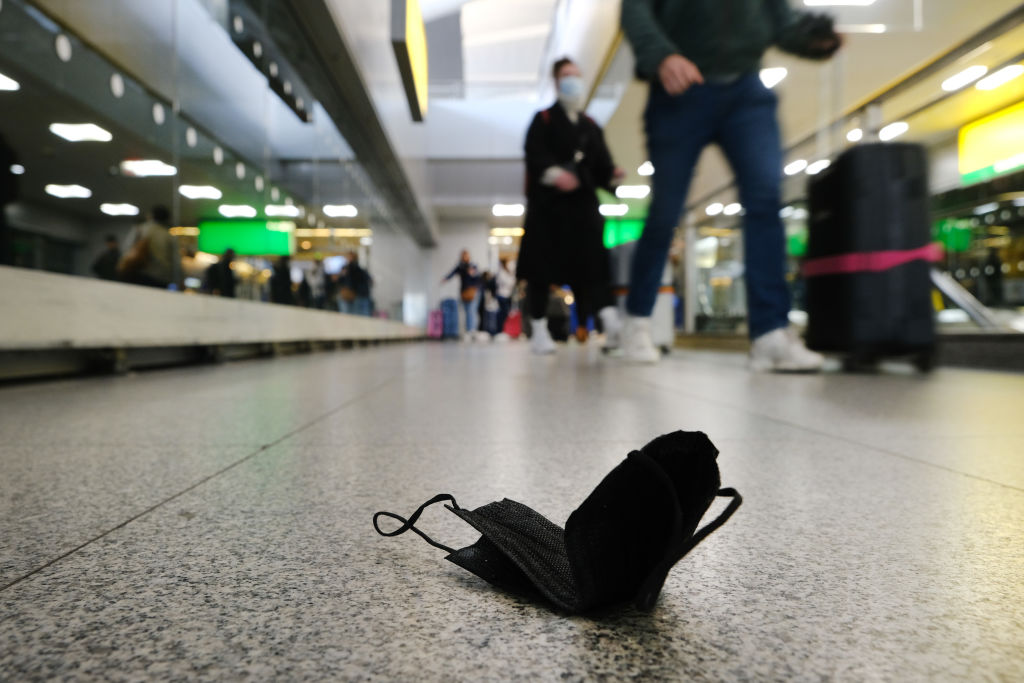A mask is seen on the ground at John F. Kennedy Airport on April 19, 2022 in New York City. (Spencer Platt/Getty Images)
As new vaccines become available, COVID-19’s spread is rising in Idaho and across the nation.
Data suggest Idaho’s current uptick — from lower levels earlier this summer and late spring — isn’t as severe as early pandemic surges.
But Idaho public health experts are bracing for COVID levels to rise even more in the coming months. That’s as the school year starts, and respiratory viruses typical season approaches.
New COVID-19 vaccines will soon be in Idaho. But for flu shots, here’s why to wait.
“It’s probably going to get worse in the fall and winter,” Idaho epidemiologist Dr. Christine Hahn told the Sun in an interview last week, adding that Idaho hospitals say they aren’t strained by the COVID uptick.
But the public has significantly less data to make personal health decisions, for instance, about mask wearing and limiting public outings. Since public health entities declared COVID no longer a public health emergency, data reporting around the coronavirus has dropped off.
There’s no longer daily case counts. Federally required hospitalization data — which stopped in May — is set to soon return starting in November.
Dr. David Pate, former CEO of St. Luke’s Health System, said it looks likely that the surge has peaked. But he stressed that it’s easier to make that call with more information.
“Of course, it will not be long until we have a new surge,” he told the Sun last week.
GET THE MORNING HEADLINES DELIVERED TO YOUR INBOX
How can we tell how much COVID is spreading in Idaho?
Here’s what key COVID data for Idaho show:
Wastewater: While the CDC reports Idaho’s wastewater COVID levels are “very high,” the rate of detecting the virus in wastewater isn’t “nearly as high as it was last winter,” Hahn said. Idaho’s current wastewater levels are 42% higher than the national rate, and 33% higher than the rate for the western U.S., CDC data show. Idaho was among 31 states with “very high” levels, CDC data for the week ending Aug. 29 show.
Emergency room visits: Visits to Idaho emergency departments for COVID-like illnesses are up compared to lower levels this summer, with 93 hospitalizations reported on Aug. 14, compared to 57 on June 16. But Idaho’s latest emergency-visit levels are still well below highs this spring and winter, which peaked at 177 visits on Jan. 3. Only a fraction of people who go to the emergency room get admitted to the hospital for COVID, Hahn said. But the emergency data is an indicator of people who are at risk of hospitalization, she said.
Hospitalizations: Idaho’s last hospitalization reports in late April showed 27 patients had suspected or confirmed COVID cases, compared to 103 on Jan. 15.
Deaths: Idaho’s last reported COVID-related death was on July 22. Four deaths were reported in early June, the state health department’s data showed.
What Idaho COVID data should you turn to?
There’s less data on COVID’s spread in Idaho now, compared to early in the pandemic. But some of that information is still around.
For now, wastewater is the key data point to watch, Pate said.
The Centers for Disease Control and Prevention’s National Wastewater Surveillance System reports COVID wastewater data, comparing states’ levels on a map. The CDC shares historical wastewater data for states.
Data from the CDC shows wastewater levels in the West are higher than levels nationally and compared to most other U.S. regions. While the West’s high levels fell the week of Aug. 24, the CDC’s reporting showed the West’s latest wastewater levels were still higher than many weeks in 2022 and 2023.
“This was the highest level of wastewater in the Western part of the United States that we have had. So it does appear that these were very high levels, probably rivaling what level of transmission we had last winter at the end of the year,” Pate said last week.
Idaho’s COVID data set for disruption after state lawmakers reject millions in federal aid
But since the Idaho Legislature in 2023 rejected $16 million in federal grants, Idaho has less COVID wastewater data, the Sun reported. Only three Idaho sites recently reported wastewater data to the Centers for Disease Control, compared to an average of 17 sites per U.S. state.
Idaho’s contributing wastewater sites are two in the city of Boise, along with one in Coeur d’Alene, Hahn said. That leaves Idaho without data from eastern or south central Idaho, she said.
Data by the city of Boise shows the latest wastewater levels, on Aug. 28, were higher than in the summer and late spring, but below a surge in early 2024.
The Centers for Disease Control and Prevention still reports test positivity rates by state, which was 14.3% for Idaho in the week ending Aug. 24.
The Idaho Department of Health and Welfare Health’s COVID dashboard, called Get Healthy Idaho, reports: emergency department visits, deaths and historical hospitalization levels.
SUPPORT NEWS YOU TRUST.

